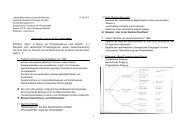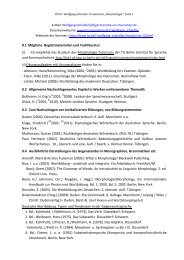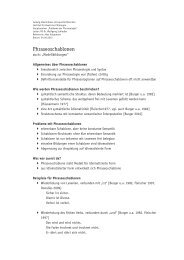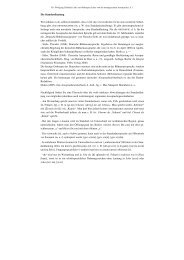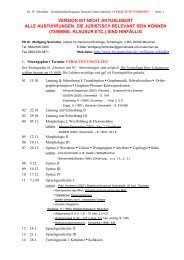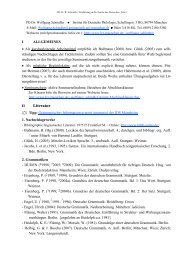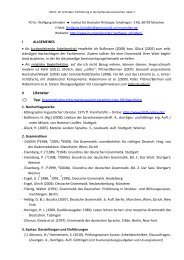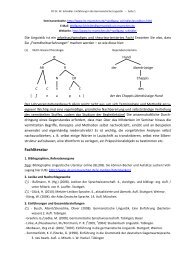Chapter 18 Lexical Functions: Description of Lexical Relations in a ...
Chapter 18 Lexical Functions: Description of Lexical Relations in a ...
Chapter 18 Lexical Functions: Description of Lexical Relations in a ...
You also want an ePaper? Increase the reach of your titles
YUMPU automatically turns print PDFs into web optimized ePapers that Google loves.
—<strong>Chapter</strong> <strong>18</strong>. <strong>Lexical</strong> <strong>Functions</strong>— 25<br />
5. 10 semantic group<strong>in</strong>gs <strong>of</strong> (simple standard) LFs can be dist<strong>in</strong>guished:<br />
Paradigmatic LFs<br />
1) Basic LFs: Syn(onym), Anti [= antonym], and Conv(ersive) ij . They correspond to the ma<strong>in</strong><br />
three semantic relations that play a special role <strong>in</strong> MT-theory—synonymy, negation, and con-<br />
verseness (X precedes Y ≡ Y follows X).<br />
2) (Semantic) derivations are <strong>of</strong> two subtypes:<br />
—Structural derivations represent nom<strong>in</strong>alization S 0 (REJECTION from REJECT), adjectivali-<br />
zation A 0 (URBAN from CITY), adverbialization Adv 0 (WELL from GOOD, FIVE TIMES from FIVE),<br />
and verbalization V 0 (ATTACKV from ATTACKN).<br />
—Mean<strong>in</strong>gful derivations are, roughly speak<strong>in</strong>g, agent noun S 1, patient noun S 2, active adjec-<br />
tival A 1 (<strong>in</strong> search [<strong>of</strong> N] from LOOK [for N]), passive adjectival A 2 (under construction from<br />
BUILD), place noun S loc (bedroom from SLEEP), <strong>in</strong>strument noun S <strong>in</strong>str,<br />
(syr<strong>in</strong>ge from INJECT),<br />
active potential adjective Able 1 (<strong>in</strong>quisitive from ASK: ≈ (who tends to ask)), passive potential<br />
adjective Able 2<br />
(reliable from RELY), etc.<br />
3) Generics: hyperonym Gener (LIQUID substance) and metaphoric denotation Figur (flame <strong>of</strong><br />
PASSION).<br />
Syntagmatic LFs<br />
4) Quantifiers: s<strong>in</strong>gulative S<strong>in</strong>g (speck <strong>of</strong> DUST) and collective Mult (pride <strong>of</strong> LIONS).<br />
5) Modifiers: cliché Epit (proud PARENTS), <strong>in</strong>tensifier Magn, Plus/M<strong>in</strong>us ((more Magn), as <strong>in</strong><br />
grow<strong>in</strong>g CONCERN, and (less Magn), as <strong>in</strong> fall<strong>in</strong>g DISCIPLINE), objective qualifier Ver (restful SLEEP,<br />
(healthy, nutricious MEAL), and subjective qualifier Bon (valuable CONTRIBUTION, exquisite MEAL).<br />
6) Semi-auxiliaries (= support, or light, verbs): semantically empty, or emptied, verbs l<strong>in</strong>k<strong>in</strong>g<br />
a DSynt-Actant [= DSyntA] <strong>of</strong> L to L, namely Oper 1/2 (give/take an EXAM), Func 0/1/2 (A CHANGE<br />
occurs/comes from the boss/affects our plans) and Labor 12/21 (submit the thief to an INTERROGA-<br />
TION/leave Mary a WIDOW).<br />
7) Phasals: verbs denot<strong>in</strong>g the three phases <strong>of</strong> an event—the beg<strong>in</strong>n<strong>in</strong>g (Incep), the end (F<strong>in</strong>),<br />
and the cont<strong>in</strong>uation (Cont). These LFs are <strong>of</strong>ten used comb<strong>in</strong>ed with other verbal LFs to produce<br />
complex LFs, e.g., IncepOper 1, ContFunc 0, etc.


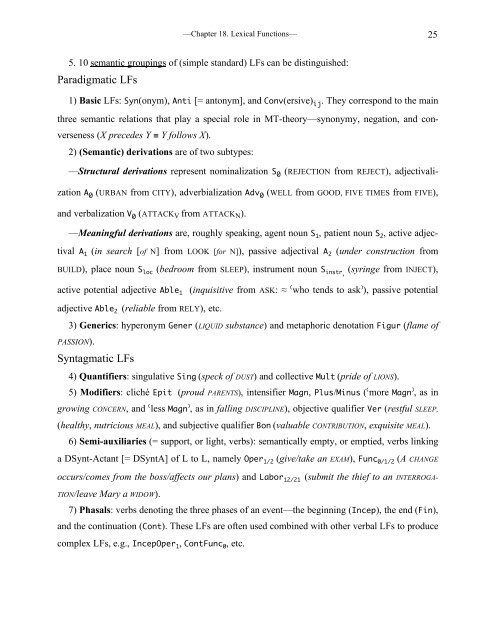
![E-Mail: Wolfgang.Schindler[ätt]germanistik.uni-muenchen.de Web ...](https://img.yumpu.com/51590147/1/184x260/e-mail-wolfgangschindlerattgermanistikuni-muenchende-web-.jpg?quality=85)
